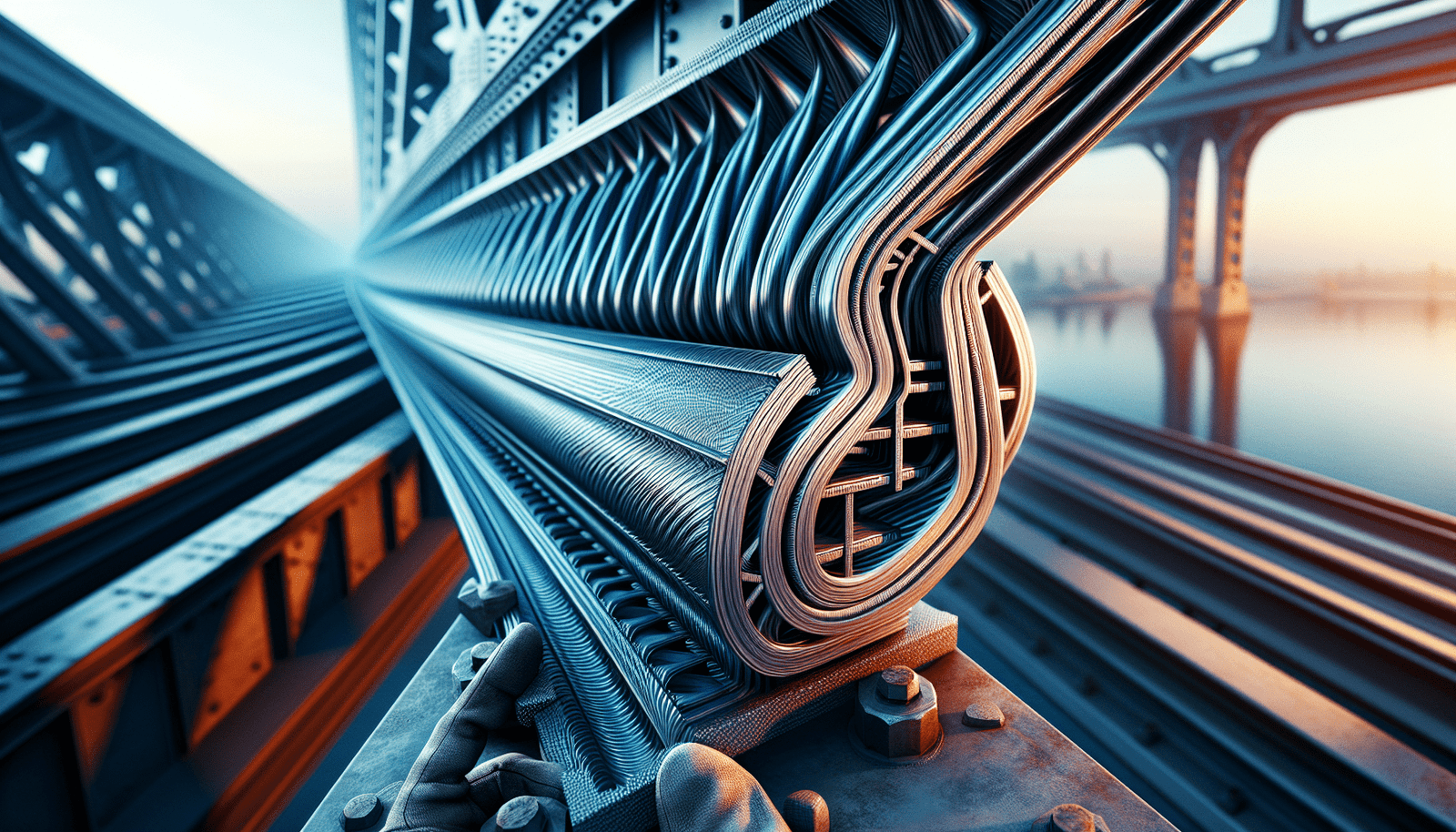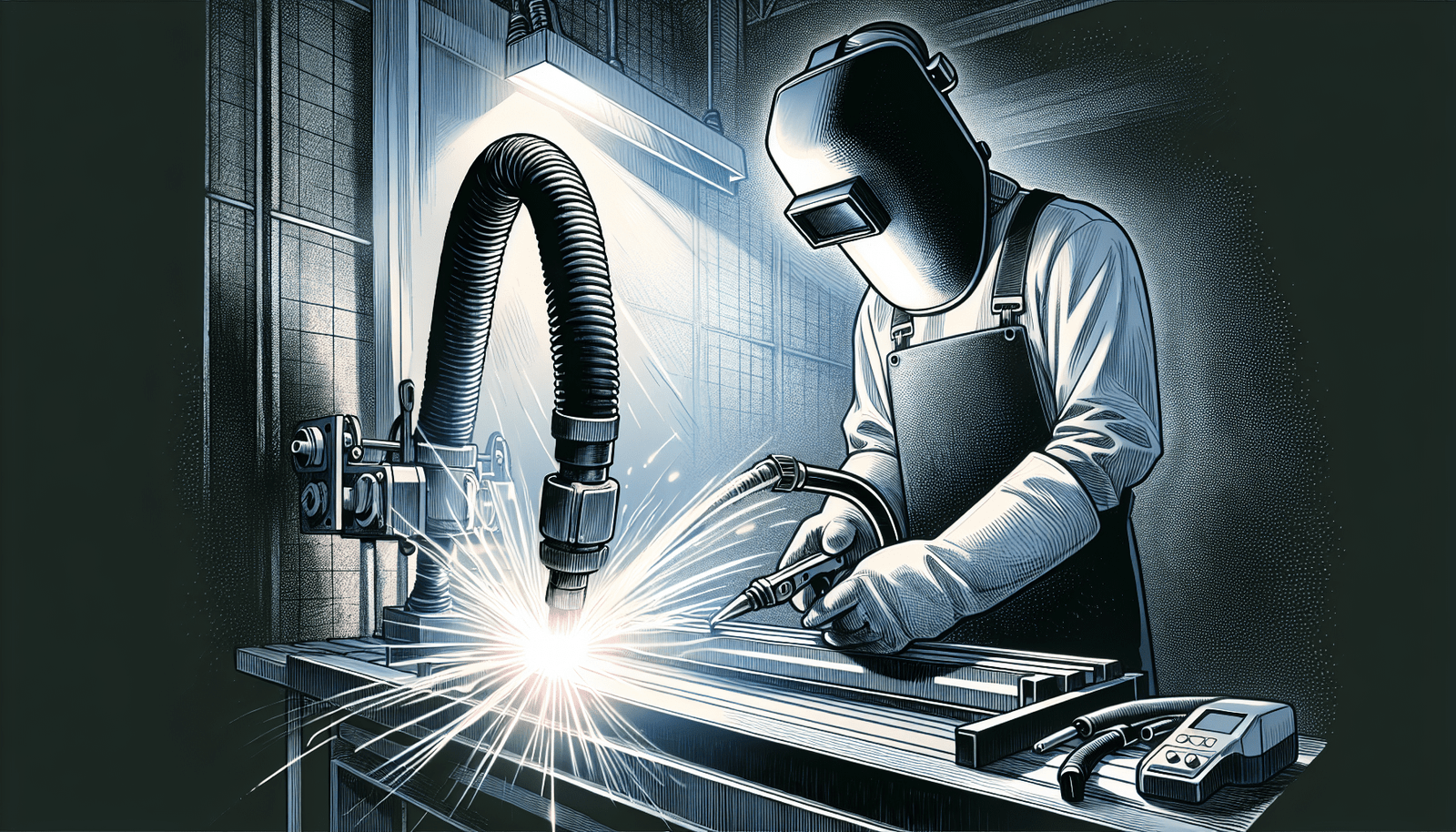You’ve always been fascinated by the intricate design and engineering behind bridges. From the towering suspension bridges to the elegant arches, each bridge tells its own story of human ingenuity and innovation. In this article, we will explore the top 10 bridge construction techniques that have shaped the infrastructure of our modern world. Whether you’re a welding guru or simply curious about the process, this friendly guide will provide you with a glimpse into the world of bridge construction. So grab a cup of coffee, sit back, and let’s embark on this journey together!
Beam Bridges Construction Technique
Definition and basic design concept
Beam bridges are one of the simplest and most common types of bridges. As the name suggests, they are constructed using a beam or multiple beams that span from one support to another. The basic design concept of beam bridges involves placing a horizontal beam, also known as a girder, across two or more supports, creating a simple yet effective structure to carry loads.
Materials commonly used
Beam bridges can be constructed using a variety of materials, depending on factors such as the length and intended use of the bridge. Commonly used materials for beam bridges include steel, concrete, and timber. Steel beams offer strength and durability, making them suitable for longer spans and heavy loads. Concrete beams are often used for shorter spans and provide high strength and resistance to weathering. Timber beams, while less common, are lightweight and cost-effective, making them suitable for smaller bridges or pedestrian walkways.
The process of construction
The construction of beam bridges typically involves several key steps. First, the location and design of the bridge are determined based on factors such as the length of the span, anticipated load, and the environment in which the bridge will be built. Then, the supports for the bridge, such as piers or abutments, are constructed. Once the supports are in place, the beams are positioned and secured on top of the supports. Additional components, such as deckings or guardrails, may be added to complete the bridge.
Key advantages and disadvantages
Beam bridges offer several advantages. They are relatively simple to design and construct, making them cost-effective and efficient. Beam bridges also provide clear visibility for drivers and pedestrians, as they do not have any piers or arches obstructing the view. However, beam bridges are limited in terms of the length they can span compared to other bridge types. They also require additional supports, which can restrict water flow in rivers and cause potential flood risks. Additionally, beam bridges may require periodic maintenance due to exposure to weathering and other environmental factors.
Arch Bridges Construction Technique
Definition and essential design elements
Arch bridges are characterized by their curved structure, which allows them to distribute weight and withstand forces through compression. The essential design element of arch bridges is the curved arch, which transfers the load from the bridge deck to the abutments or piers. The curvature of the arch provides inherent strength, allowing arch bridges to span larger distances than beam bridges.
Different types of materials used
Arch bridges can be constructed using various materials, including stone, brick, concrete, steel, and even lightweight materials such as carbon fiber. Stone and brick arch bridges were common in ancient civilizations and are known for their aesthetic appeal. Concrete arch bridges offer strength and durability, making them suitable for modern bridge construction. Steel arch bridges are often used for longer spans and can be prefabricated or built on-site for ease of construction.
Steps involved in arch bridge construction
The construction of an arch bridge involves several steps. First, the site is prepared, and the foundations are built to support the bridge. Then, the arch is constructed piece by piece, either by using a temporary falsework or by using a formwork that supports the arch during construction. Once the arch is complete, the deck and other components, such as railings, are added to finish the bridge.
Benefits and drawbacks
Arch bridges offer several advantages. They are known for their strength and ability to span longer distances, making them suitable for large-scale projects. The curved shape of arch bridges also adds an aesthetic value, making them iconic structures. However, arch bridges can be more expensive and time-consuming to construct compared to other bridge types. The design and construction process may require specialized expertise and equipment. Additionally, arch bridges may have limited horizontal clearance due to the curvature of the arch, which can be a consideration in certain locations.
Cantilever Bridges Construction Technique
Understanding the basic design of cantilever bridges
Cantilever bridges are characterized by their unique design, which utilizes cantilevers to support the bridge deck. Cantilevers are horizontal beams that extend outward and are anchored at one end, creating a rigid structure that can support loads without the need for additional intermediate supports. The basic design of cantilever bridges allows for longer spans and greater flexibility in bridge construction.
Exploring the materials used
Cantilever bridges can be constructed using various materials, including steel, concrete, and composite materials. Steel cantilever bridges offer high strength and durability, making them suitable for longer spans and heavy loads. Concrete cantilever bridges provide excellent resistance to weathering and can be cost-effective for certain applications. Composite materials, such as fiber-reinforced polymers, offer a combination of strength and lightweight properties, making them a viable option for innovative bridge designs.
Construction process overview
The construction of cantilever bridges involves several key steps. First, the foundation supports, such as piers or abutments, are constructed. Then, the cantilever beams are extended outward from these supports, gradually adding segments until they meet in the middle. Once the cantilevers are connected, the bridge deck is added to complete the structure. Additional components, such as railings or barriers, may also be included in the construction process.
Pros and cons
Cantilever bridges offer several advantages. Their design allows for longer spans without the need for additional intermediate supports, making them suitable for crossing deep ravines or large bodies of water. Cantilever bridges also provide flexibility in construction, allowing for incremental building and adjustment during the construction process. However, cantilever bridges can be complex to design and construct, requiring careful engineering and planning. They may also require periodic maintenance due to exposure to environmental factors. Additionally, cantilever bridges may have higher construction costs compared to other bridge types due to the specialized design and construction techniques involved.
Suspension Bridges Construction Technique
Core design principles
Suspension bridges are characterized by their suspended deck, which is supported by vertical suspenders connected to main cables. The core design principle of suspension bridges involves balancing tension and compression forces to create a stable and efficient structure. The main cables, anchored at both ends, carry the majority of the load and are supported by towers or piers, while the suspenders transfer the load to the main cables.
Material selection for suspension bridges
Suspension bridges require materials that can withstand high tension forces while providing durability and flexibility. The main cables are typically made of high-tensile steel or, in some cases, pre-stressed concrete. The suspenders can also be made of steel or other high-strength materials. The bridge deck is usually constructed using concrete or steel, depending on the desired load capacity and design requirements.
Overview of the construction process
The construction of suspension bridges involves several key steps. First, the foundations, such as towers or piers, are constructed to support the main cables. Then, the main cables are installed, typically by using temporary supports or cranes. Once the main cables are in place, the suspenders are attached, and the bridge deck and other components, such as towers and pylons, are added. The construction process requires careful coordination and precision to ensure the stability and integrity of the bridge.
Advantages and limitations
Suspension bridges offer several advantages. They can span long distances, making them suitable for crossing large bodies of water or deep valleys. The design of suspension bridges also allows for flexibility and adaptability, making them resilient to factors such as wind or seismic activity. Suspension bridges are often considered architectural landmarks, adding aesthetic value to the surrounding environment. However, suspension bridges can be expensive to construct and maintain due to their complex design and the materials required. They may also have limited vertical clearance, which can impact navigation under the bridge.
Cable-Stayed Bridges Construction Technique
Underlying design concept
Cable-stayed bridges are characterized by their distinctive tower-like structures and cables that support the bridge deck. The underlying design concept of cable-stayed bridges involves using cable stays to transfer the load from the bridge deck to the towers or pylons. The cables are arranged in a fan-like or harp-like pattern, providing stability and distributing the load evenly.
Suitable choice of materials
Cable-stayed bridges can be constructed using various materials, including steel, concrete, and composite materials. Steel cable-stayed bridges offer strength and durability, making them suitable for longer spans and heavy loads. Concrete cable-stayed bridges provide excellent resistance to weathering and can be cost-effective for certain applications. Composite materials, such as carbon fiber, offer a combination of strength and lightweight properties, allowing for innovative and efficient bridge designs.
Construction procedure
The construction of cable-stayed bridges involves several key steps. First, the tower or pylon supports are constructed, typically using reinforced concrete or steel. Then, the cables are attached to the towers and stretched to the desired tension, using temporary supports or hydraulic jacks. Once the cables are in place, the bridge deck is added, and additional components, such as railings or barriers, may be included. The construction process requires precise coordination and expertise to ensure the stability and safety of the bridge.
Benefits and limitations
Cable-stayed bridges offer several benefits. They offer a visually striking design that can become iconic landmarks in urban landscapes. Cable-stayed bridges can also be constructed efficiently, as the main structural elements can be prefabricated and assembled on-site. The design allows for longer spans and increased flexibility compared to other bridge types. However, cable-stayed bridges can be more expensive to construct compared to some other bridge types due to the complex design and construction process. They may also require periodic maintenance, particularly for the cables and the tower structures. Additionally, cable-stayed bridges may have limited horizontal clearance due to the presence of the tower structures.
Truss Bridges Construction Technique
Breakdown of the design concept
Truss bridges are characterized by their triangular truss framework, which provides strength and stability. The design concept of truss bridges involves using a series of interconnected triangles to distribute the load evenly across the bridge. The triangular truss framework forms a rigid structure that can support heavy loads and span long distances.
Choice of materials
Truss bridges can be constructed using various materials, including steel, timber, and concrete. Steel truss bridges offer high strength and durability, making them suitable for longer spans and heavy loads. Timber truss bridges, while less common nowadays, can be aesthetically pleasing and cost-effective for smaller bridges or pedestrian walkways. Concrete truss bridges provide excellent resistance to weathering and can be suitable for certain applications where appearance and durability are important factors.
Explanation of construction steps
The construction of truss bridges involves several steps. First, the foundation supports, such as piers or abutments, are constructed. Then, the truss framework is fabricated either on-site or off-site and transported to the construction site. The truss sections are assembled and connected through bolts or welding, creating the desired bridge shape. Once the truss framework is complete, the bridge deck and additional components, such as railings or guardrails, are added to finish the bridge.
Advantages and potential downsides
Truss bridges offer several advantages. They are known for their strength and ability to span longer distances, making them suitable for large-scale projects. Truss bridges also provide a visually appealing design, especially for historic or architectural purposes. The design allows for flexibility in construction, as the truss framework can be modified or adjusted according to the specific requirements of the project. However, truss bridges may have limited vertical clearance due to the height of the truss framework. The construction process can also be more complex compared to other bridge types, requiring specialized expertise and equipment. Additionally, truss bridges may require periodic maintenance due to environmental factors, such as exposure to weathering and corrosion.
Pontoon Bridges Construction Technique
Defining the design principle
Pontoon bridges are characterized by their floating structure, which utilizes pontoons or hollow tubes to support the bridge deck. The design principle of pontoon bridges involves using the buoyancy of the pontoons to provide stability and load-bearing capability. The pontoons are typically attached to each other and secured to the shore or riverbed to create a stable platform for crossing.
Detailing the materials typically used
Pontoon bridges can be constructed using various materials, including steel, concrete, and plastic pontoons. Steel pontoons offer strength and durability, making them suitable for heavy loads and longer spans. Concrete pontoons provide excellent resistance to weathering and can be cost-effective for certain applications. Plastic pontoons are lightweight and easy to install, making them a viable option for temporary or portable bridges.
Description of the construction procedure
The construction of pontoon bridges involves several steps. First, the pontoons are strategically positioned in the water, ensuring proper spacing and alignment. The pontoons are then connected to each other using brackets, hinges, or other fastening methods. Once the pontoon framework is complete, the bridge deck is added, usually using prefabricated sections that are secured to the pontoons. Additional components, such as railings or barriers, may be included to enhance safety and usability.
Pros and cons
Pontoon bridges offer several advantages. They are relatively quick and easy to assemble, making them suitable for temporary or emergency situations. Pontoon bridges can also be cost-effective compared to other bridge types, particularly for shorter spans or locations with fluctuating water levels. The floating structure allows for adaptation to changing water conditions and provides flexibility in deployment. However, pontoon bridges may have limited load capacity compared to some other bridge types, as the buoyancy of the pontoons may have weight limitations. They may also be susceptible to damage from strong currents or ice conditions. Additionally, pontoon bridges may require regular maintenance to ensure the stability and integrity of the pontoons and connections.
Trestle Bridges Construction Technique
Elaboration of the design concept
Trestle bridges are characterized by their interlocking framework of horizontal and vertical supports, creating a stable structure to carry loads. The design concept of trestle bridges involves using a series of vertical posts, called piles or bents, to support horizontal beams or trusses. The combination of vertical and horizontal elements provides strength and stability to the bridge structure.
Insight into the material selection
Trestle bridges can be constructed using various materials, including timber, steel, and concrete. Timber trestle bridges, historically common, offer a rustic and aesthetically pleasing design. Steel trestle bridges provide high strength and durability, making them suitable for longer spans and heavy loads. Concrete trestle bridges offer excellent resistance to weathering and can be cost-effective for certain applications, such as railway crossings.
Stepwise construction process
The construction of trestle bridges involves several key steps. First, the vertical supports or piles are driven into the ground, typically using piling rigs or pile drivers. The piles are then capped with horizontal beams or trusses, forming the framework of the trestle bridge. Additional cross-bracing or diagonal bracing is added to enhance the stability and load-bearing capacity. Once the framework is complete, the bridge deck or track is added on top, and other components, such as railings or guardrails, may be installed.
Upsides and downsides
Trestle bridges offer several upsides. They can span long distances and provide an efficient solution for bridging challenging terrains, such as valleys or ravines. The design allows for adaptability to uneven ground conditions, making trestle bridges suitable for locations with varying elevations. Trestle bridges also offer flexibility in construction, as they can be assembled incrementally or modified as needed. However, trestle bridges may have higher construction costs compared to other bridge types, particularly if deep foundations or extensive bracing are required. They may also have limited horizontal clearance due to the presence of the vertical supports. Additionally, trestle bridges made from timber may require regular maintenance due to exposure to weathering and potential decay.
Rigid Frame Bridges Construction Technique
Explanation of the design principle
Rigid frame bridges are characterized by their rigid and continuous framework, which provides stability and load-bearing capability. The design principle of rigid frame bridges involves using horizontal beams, known as girders, that are connected to vertical supports. The connection between the beams and supports creates a rigid structure that can support heavy loads and distribute forces effectively.
Commonly used materials
Rigid frame bridges can be constructed using various materials, including steel, concrete, and composite materials. Steel rigid frame bridges offer high strength and durability, making them suitable for longer spans and heavy loads. Concrete rigid frame bridges provide excellent resistance to weathering and can be cost-effective for certain applications. Composite materials, such as fiber-reinforced polymers, offer a combination of strength and lightweight properties, allowing for innovative and efficient bridge designs.
Construction method details
The construction of rigid frame bridges involves several key steps. First, the foundations, such as piers or abutments, are constructed to support the vertical supports. Then, the girders or horizontal beams are installed and connected to the supports. The connections between the girders and supports are critical in creating a rigid and continuous structure. Once the framework is complete, the bridge deck and other components, such as railings or barriers, are added to finish the bridge.
Benefits and potential drawbacks
Rigid frame bridges offer several benefits. They are known for their strength and stability, allowing for efficient load distribution and resistance to external forces. Rigid frame bridges can span longer distances and provide flexibility in design, making them suitable for various applications. The construction process for rigid frame bridges is relatively straightforward compared to some other bridge types, requiring standard engineering techniques. However, rigid frame bridges may have higher construction costs compared to certain bridge types due to the complexity of the framework and the materials involved. They may also require periodic maintenance, particularly for inspection of the connections and structural integrity. Additionally, the design of rigid frame bridges may have restrictions in terms of clearance height and span length.
Girder Bridges Construction Technique
Description of the essential design elements
Girder bridges are characterized by their use of horizontal girders or beams that span between supports, creating a stable structure for carrying loads. The essential design elements of girder bridges involve placing one or multiple girders across two or more supports, typically piers or abutments. The girders distribute the load from the bridge deck to the supports, allowing for efficient load transfer.
Materials used for construction
Girder bridges can be constructed using various materials, including steel, concrete, and composite materials. Steel girders provide high strength and durability, making them suitable for longer spans and heavy loads. Concrete girders offer excellent resistance to weathering and can be cost-effective for certain applications. Composite materials, such as fiber-reinforced polymers, offer a combination of strength and lightweight properties, allowing for innovative and efficient bridge designs.
Process of construction
The construction of girder bridges involves several key steps. First, the location and design of the bridge are determined based on factors such as the length of the span, anticipated load, and the environment in which the bridge will be built. Then, the supports for the bridge, such as piers or abutments, are constructed. Once the supports are in place, the girders are positioned and secured on top of the supports. Additional components, such as deckings or guardrails, may be added to complete the bridge.
Advantages and possible limitations
Girder bridges offer several advantages. They are relatively simple in design and can be cost-effective to construct, making them commonly used for various structures, including highway overpasses and pedestrian walkways. Girder bridges provide clear visibility for drivers and pedestrians, offering an open and unobstructed view. However, girder bridges may have limitations in terms of the length they can span compared to other bridge types. They also require additional supports, which can restrict water flow in rivers and cause potential flood risks. Additionally, girder bridges may require periodic maintenance due to exposure to weathering and other environmental factors.





